Viable potato variety Golubizna with amazing taste
The Golubizna variety got its name for the bright blue color of the flowers during the flowering period. Due to the large fruit and late harvest time, the crop is more suitable for personal cultivation than for commercial cultivation. The tubers have excellent taste, do not degenerate for a long time, and are used for frying, boiling, baking, and producing starch and alcohol.
You will receive all the useful information about Golubizna potatoes with a description of the variety and photos in this material.
Description of the variety
The mid-late potato Golubizna is a variety bred by biologists of the All-Russian Research Institute of Potato Farming named after. A.G. Lorkha" by crossing hybrid 128-6 with the Gatchinsky variety. The culture was included in the State Register of the Russian Federation in 1993.
A patent for the sale of seed material is held by:
- LLC "Agrocenter Korenevo";
- LLC "Im. Pryakhina V.G.”;
- Peasant farm "Egorsha";
- JSC "Teplichny";
- LLC "Green Lines - Kaluga";
- LLC "Greenhouse plant "Elite-Potato";
- LLC "Redkinskaya agro-industrial company";
- LLC FH "SeDeK";
- FSBEI HE RGAU-MSHA named after K. A. Timiryazev.”
In the photo - Golubizna potatoes.
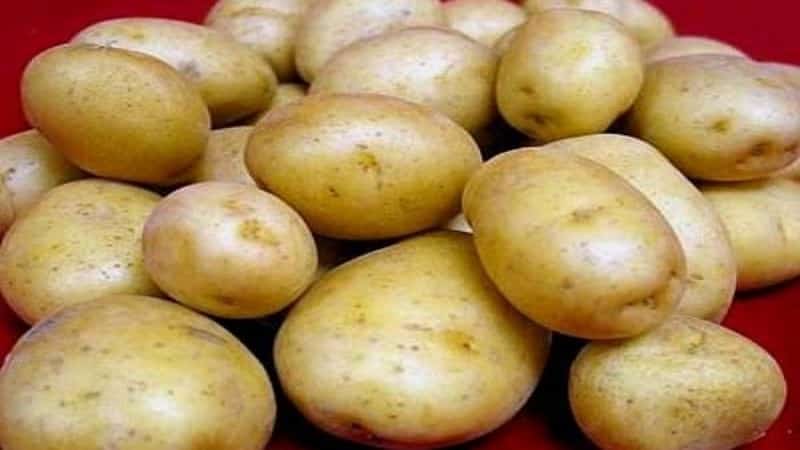
The table summarizes the main features of the variety.
| Indicators | Characteristic |
|---|---|
| Ripening period | 100-115 days |
| Bush | Medium height, semi-erect |
| Number of tubers in a bush | 9-11 |
| Weight | 90-110 g |
| Form | Oval, oblong |
| Coloring | The peel is beige with shallow blue eyes, the flesh is creamy |
| Leaves | Medium size, dark green, glossy |
| Corolla color | White-violet (cornflower blue) |
| Starch content | 17-19% |
| Taste | Excellent (5 on a five-point scale) |
| Cooking class/group | C (highly crumbly) |
| Productivity | 400-500 c/ha |
| Marketability | 98% |
| Keeping quality | 90-95% |
| Purpose | Dining room |
| Sustainability | To virus Y, Alternaria blight, common scab, rhizoctonia, potato cancer, ring and wet rot, late blight of tops and tubers |
| Transportability | High |
Chemical composition
The table shows the complex of vitamins and minerals contained in 100 g of raw tubers.
| Name | Content | Norm |
|---|---|---|
| Beta carotene | 0.001 mg | 5 mg |
| Vitamin B1 | 0.081 mg | 1.5 mg |
| Vitamin B2 | 0.032 mg | 1.8 mg |
| Vitamin B4 | 12.1 mg | 500 mg |
| Vitamin B5 | 0.295 mg | 5 mg |
| Vitamin B6 | 0.298 mg | 2 mg |
| Vitamin B9 | 15 mcg | 400 mcg |
| Vitamin C | 19.7 mg | 90 mg |
| Vitamin E | 0.01 mg | 15 mg |
| Vitamin K | 2 mcg | 120 mcg |
| Vitamin PP | 1.061 mg | 20 mg |
| Potassium | 425 mg | 2500 mg |
| Calcium | 12 mg | 1000 mg |
| Magnesium | 23 mg | 400 mg |
| Sodium | 6 mg | 1300 mg |
| Phosphorus | 57 mg | 800 mg |
| Iron | 0.81 mg | 18 mg |
| Manganese | 0.153 mg | 2 mg |
| Copper | 110 mcg | 1000 mcg |
| Selenium | 0.4 mcg | 55 mcg |
| Zinc | 0.3 mg | 12 mg |
Growing regions
The crop has received permission to grow in the following regions:
- Central;
- Volgo-Vyatsky;
- Central Black Earth;
- North Caucasian.
Advantages and disadvantages
Advantages of culture:
- drought resistance - roots grow deeply into the soil in search of moisture;
- resistance to changes in air temperature and prolonged cold;
- adaptation to conditions of close occurrence of groundwater;
- strong immunity;
- high productivity, increasing when tubers germinate;
- excellent taste;
- increased content of amino acids;
- lack of tendency to degenerate tubers.
Disadvantage - the variety is prone to infection with golden potato nematode.
Features of planting and growing
The Golubizna variety is grown using standard technology in ridges or ridges. Potatoes are resistant to drought without loss of yield, but when there is a lack of moisture, the tubers become deformed. If there is an excess of moisture and nitrogen, hollowness (emptiness inside the tubers) is possible.
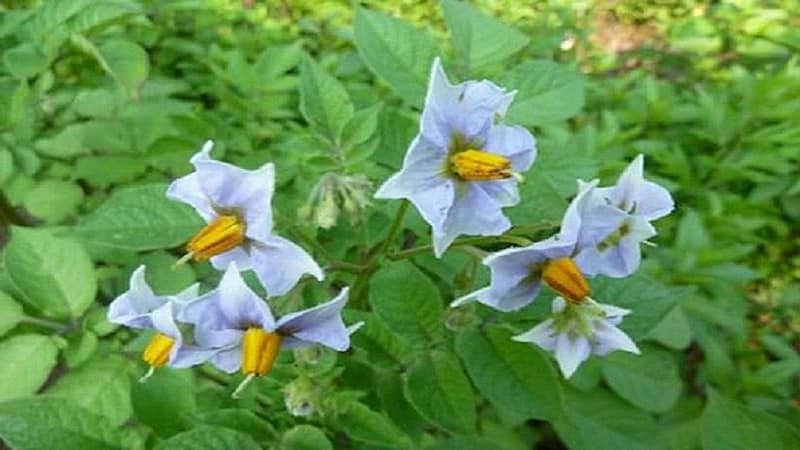
Tuber preparation
Tubers of the Golubizna variety are stored for a long time in a cool place and do not germinate when the temperature rises by +1-2°C. Therefore, seeds selected for planting are brought into the light for vernalization (adaptation to climatic conditions) 35-40 days before planting, if the traditional method of germination in boxes is provided. The tubers are washed, dried and soaked for 20 minutes in a solution of boric acid (10 g/10 l). Then they are placed in clean boxes and left in a bright place at an air temperature of at least +15°C.
To speed up the emergence of seedlings, the method of vernalization in a humid environment is used. Tubers are dipped in “Epin” or “Zircon”. The bottom of the box is lined with film, and a damp, loose substrate or sawdust is poured on top. The tubers are laid out in one layer and covered with the same substrate on top. The main goal is to maintain a constantly moist environment. Seedlings will appear in 20-25 days.
Soil preparation
Potatoes of this variety are grown on any type of soil. The best results can be achieved when grown on loamy, clayey and sandy loam soils.
In the fall, the plot is dug up, loosened and fertilized with manure, and in the spring it is sown with green manure. Potatoes grow best after lupine, oats, wheat, legumes, and rapeseed. After a month, the cuttings are embedded in the soil in order to enrich them with mineral compounds, loosen them and prevent the development of pathogenic microorganisms.
Dates, scheme and rules of planting
The timing of planting potatoes depends on the region of cultivation: in the northern regions, planting begins in the second ten days of May, in the central regions - in early May, in the south - at the end of April. Experienced farmers recommend not delaying planting, otherwise the tubers will not have time to ripen or the storage period will be reduced. When late landing In overheated soil, the starch content decreases and the nitrate level increases.
The seed material of the Golubizna variety is large in size, so before planting the tubers are cut into pieces, leaving three or more eyes on each. The cut is sprinkled with wood ash.
Planting is done in dry soil, heated to +6...+8°C. The holes are formed up to 10 cm deep. A handful of ash and onion peels are placed in each hole to protect against wireworms and the Colorado potato beetle. The holes are filled with earth and leveled with a rake.
Thickened planting is recommended for the variety. A distance of 25 cm is maintained between the pits, and 60-65 cm between the rows.
Care
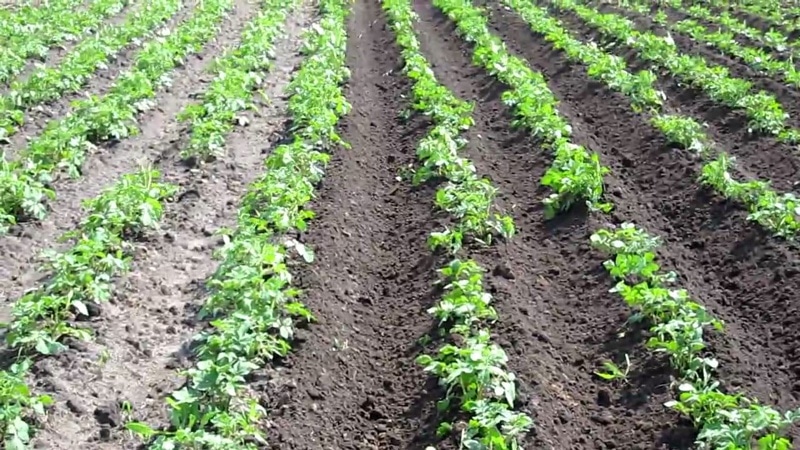
Rules for caring for plantings:
- The beds are watered at least 3 times per season. During drought, the amount of watering is increased to 2 times every 10 days.
- The soil is loosened after each watering. This provides additional air flow to the root system and accelerates the formation of tubers.
- Weeds are weeded once a week, preventing them from taking root.
- Bushes spud as they grow. The first procedure is carried out a week after planting, when sprouts 5-10 cm high appear above the surface. The second time they are spudded after flowering. Sprinkling the bushes with soil promotes the formation of additional stolons and protects young nodules from frost.
- Potatoes are fed twice: during planting and flowering. The plant receives most of its nutrients from rotted green manure.Additionally, the beds are fertilized with mullein (1 liter of fresh solution/10 liters) or chicken droppings (1 tablespoon of dry matter/10 liters). During the flowering period, the bushes are fed with foliar solutions. This is due to the ability of potatoes to actively absorb nutrients through the foliage. The best feeding is considered to be nitrophoska (40 g/10 l) and sodium humate (2 g/10 l). Consumption per bush - 3-4 liters.
Disease and pest control
The Golubizna variety is immune to cancer, viral diseases and late blight, but is susceptible to infection by a hidden enemy - the golden potato nematode. The problem cannot be recognized in the early stages. Most often, plantings become infected in areas without crop rotation (potatoes are planted for 3-4 years in a row). Crop losses range from 30 to 80%.
Reference. The golden nematode is a small worm up to 1 cm in size. It reproduces at the speed of light, does not sink in water and does not burn in fire. The pest is immune to chemicals, radiation, and drought. It persists in the soil for up to 15 years and actively develops on potatoes.
Signs:
- slowing down the growth of bushes;
- the lower leaves of the sprouts turn yellow and fall off;
- the plant gradually turns completely yellow;
- the root system looks like a sponge, the roots become smaller;
- tubers are small or absent;
- there are no flowers on the bushes.
Chemical drugs against the golden nematode still do not exist, so all efforts should be aimed at preventing infection and reducing the population:
- crop rotation;
- planting potatoes after lupine, clover, wheat, peas, beans, flax;
- careful selection of seed material;
- fertilizing the soil with urea before planting (nitric acid fertilizers are toxic to nematodes);
- weed removal;
- disinfection of tubers in potassium permanganate (0.5 g/10 l of water);
- creating favorable conditions for the reproduction of earthworms - the natural enemies of the nematode - by increasing soil fertility.
In addition to the golden nematode, potato plantings are affected by the Colorado potato beetle. There are quite a few methods to combat it. Experienced farmers advise alternating chemicals with herbal infusions, planting strong-smelling plants in the beds to repel pests (nasturtium, flowering tobacco, valerian, marigolds, matthiola), attracting swifts, starlings, pheasants, guinea fowl, and ladybugs.
Folk remedies:
- 100 g soap shavings, 200 g wood ash/10 l water;
- 50 g mustard powder, 100 ml 9% vinegar / 10 l water;
- 300 g of flowering hemp, pour 5 liters of water, boil for 10 minutes, add 50 g of soap shavings;
- Pour 100 g of dry hot pepper into 10 liters of water and cook over low heat for 2 hours, add 50 g of soap shavings.
Effective chemicals:
- "Spark";
- "Commander";
- "Corado";
- "Inspector";
- "Sonnet +";
- "Anti-bug";
- "Death to Bugs";
- "Prestige";
- "Dilor."
Harvest and storage
Two weeks before digging, the tops are cut off. The harvest is harvested in late August or early September. The tubers are sorted, the soil is cleared and left to dry in a dark, dry place for 3-4 days. Potatoes selected for planting next season are laid out in an even layer under the sun for landscaping.
The storage and containers are pre-washed and disinfected. The tubers are placed in breathable boxes, bags or nets. The optimal room temperature is +2...+4°C, humidity is 70-80%.
Due to its high starch content, Blueberry is widely used in cooking, in the production of snacks and fast food, dry starch and alcohol.
Peeling in progress cooking cracks, but the flesh retains its shape.Raw potatoes do not darken after cutting.
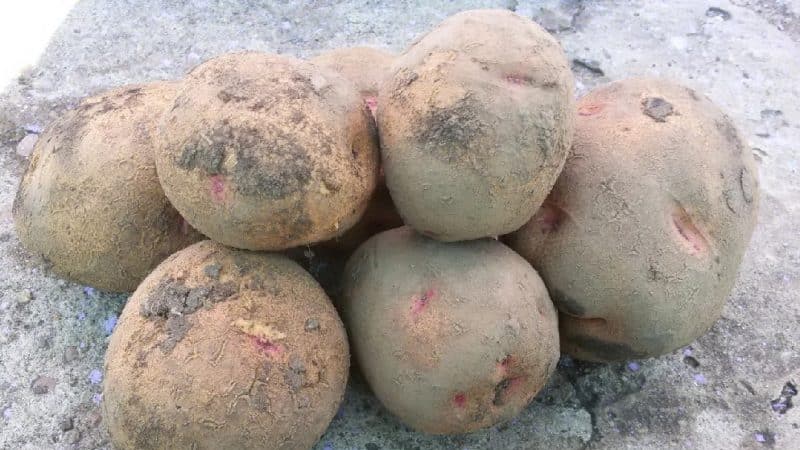
Features and possible difficulties of growing
Two methods are used to grow the variety:
- Comb. Suitable for wet and heavy soil. Using a shovel, rows 20 cm high are thrown in. 4 cm depressions are formed in them and the tubers are planted with seedlings upward at intervals of 30 cm. The advantage of the method is that the soil is enriched with oxygen by 70% more than when planting in deep holes.
- Gryadovyi - for dry soil. Seeds are planted in beds 120 cm wide, which are arranged in two rows. The row spacing is 90 cm. Tubers are planted at a depth of 4-5 cm. The advantages of the method are moisture retention in the soil, reducing the risk of soil being washed away by rainwater, and a larger volume of soil per plant.
Reviews
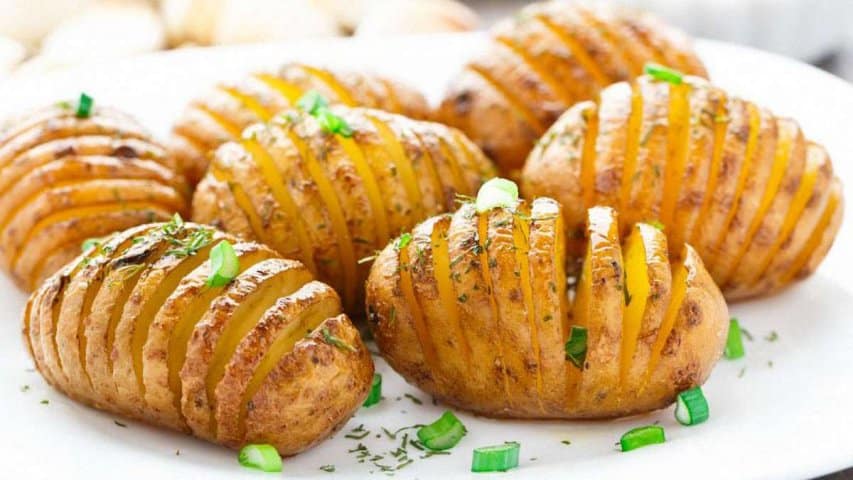
On gardener forums there are only positive reviews about the Golubizna variety.
Maria, Klintsy: «Of all the varieties that I have tried, the Golubizna potato is the record holder for the formation of tubers. One bush usually ripens 20-25 potatoes. They are all smooth, large, with small bluish eyes. The taste is excellent. Every new season I plant potatoes in a new place.”
Taras, Georgievsk: “Blue is an incomparable and the most delicious potato for me personally. The yield is high, enough to leave for the winter and sell. The taste is excellent, it gets a little overcooked, but that's okay. It makes a very tasty, airy puree.”
Read also:
Late-ripening potato variety "Cardinal".
Conclusion
The Golubizna potato has not lost its leadership position since its introduction in the early 90s of the 20th century.The variety is characterized by high productivity, resistance to major nightshade diseases, and withstands dry and cold periods. The tubers contain 17-19% starch and have an excellent taste.
Compliance with the rules of agricultural technology (watering, weeding, loosening, hilling) and preventive measures (crop rotation, disinfection of tubers, removal of plant residues) will preserve the health of the plant and protect against the golden nematode and the Colorado potato beetle.